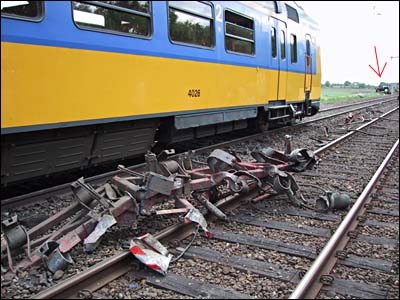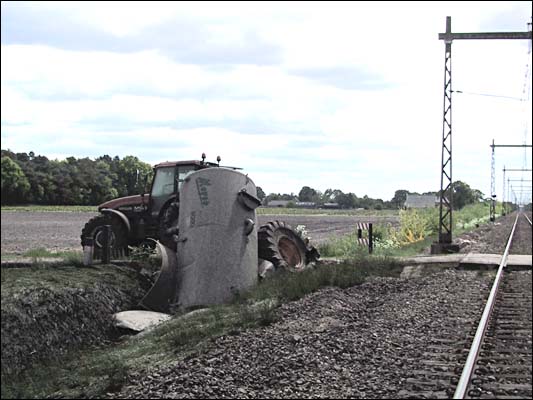| On Location (2) |

| The press photographer in me is still waking up. I was on board the train which on Monday, 21 May, just outside Assen, derailed due to a slurry tank having got in the way. At first you simply freeze. Then, after an instance of sitting there, completely dazed, you sharpen the senses, roll down the window, stick out your head and observe the front car sitting there, slightly out of whack, enveloped in a cloud of brownish dust. It would have made a wonderfully dramatic picture, but I never took it. It was only an hour later, after everyone had clambered out, that I took this picture of the rear of the train flanked by the remains of what must have been the slurry tank's undercarriage. What sort of distance does it take to spot a slurry tank, I wonder … |
|
My first question is whether anyone was unfortunate enough to end up
crushed, the second that help would in any event have been too late and the
victim (if any) probably never knew what hit him or her. The third question
instantly presents itself: how about the train driver? I was sitting at the
very rear of the train, after all. It must have been mayhem up front, or so
I hear fellow passengers tell one another half an hour later. However, a
voice over the PA system reassures us that as far as anyone can tell, there
are no casualties due to the recent accident involving a slurry tank. This
is when I find myself uttering a couple of dozen expletives. We've been
lucky, the train we were in was doing at least 60 mph at the time of the
crash, it could easily have jack-knifed so that the cars would have ended up
on top of one another, and then it would have been a different story
altogether. Try to imagine the scene: there you are, riding along in the
front car which is inundated with slurry, black dung covering the windows, a
horrific stench exploding all around you as if the train is clawing its way
into the soggy underground via an immense and terribly sludgy muck hill, and
in the midst of this scene of absolute bedlam the occasional traveller
cannot help wondering whether this is what the core of the Netherlands looks
like. However, after a while I start reconstructing the sequence of events, identifying with the tractor driver who has just beaten the grim reaper to it, looking out of the window, observing miles and miles of empty track on either side. I place myself in the position of the train driver, assuming that I would be seeing the same miles and miles of empty track and not much else. I let the train slow down gently: Assen station is just a couple of miles ahead. All of a sudden I spot a slurry tank emerge from absolutely nowhere. Bloody speed merchants, that's what they are. There's nothing I can do - big bang. Let's not kid ourselves, after all - my line of vision couldn't amount to more than, say, a third of a mile (let's not exaggerate), and a third of a mile is gone before you know it. It's always the same with these blasted unguarded level crossings, trains have such a long braking distance, what can you do? I'm back in my role as passenger, sitting in my own seat. I remember that apart from a vague sense of extremely gradual deceleration - a bit like slowing down, but without using the motor to brake - only a short sharp braking motion preceded the train's thumping shuddering which was almost too brief to count and too short to say "twenty-one". Damn, could this have been the infamous unbridgeable stretch of time generated by the train's sheer mass which in everyday words is called "braking distance" and inside which it's too late to do anything? Clearly this calls for a spot of mental arithmetic. We turn back the clock, peer over the driver's shoulder and find ourselves a third of a mile ahead of the unguarded level crossing. We're still bowling along at 80 mph or so, no worries, and yet we find ourselves muttering under our breath, for we have just spotted a slurry tank on the level crossing, a third of a mile ahead of us, or let's make it really challenging and assume that the slurry tank itself is moving. We've already done the muttering under our breath, but what do we think? Slam on the brakes even though we know it's too late, as you and I, as laymen and women, would suggest? That remains very much to be seen: when you're moving at a speed of 80 mph, it will in any event take you some 15 seconds to cover a third of a mile. Go on, be a good sport, try holding your breath for 15 seconds. Kill you it won't, but what it will do is demonstrate to you that 15 seconds is an insufferably long stretch of time to spend braking. What thoughts in the driver's head could have kept him from braking? Do they teach you in train driver school that you should first wait and see whether the unguarded level crosser might not just be in the process of getting out of the way of his own accord, in plenty of time for the steel behemoth you're driving to pass? Illogical as it may sound, braking for nothing costs money. Then again, there's nothing to be flippant about - after all it's hardly as if we're playing battleships here. Let's push on. I myself am Libra, and if we assume that the train driver shares my star sign and thus qualifies as a fellow ditherer, it may not have been until the train had sped along to come within one quarter of a mile of the slurry tank that he hit the emergency brakes. Leaving some room for negotiation, I'm perfectly happy to admit that the train, scraping along the track with fully locked wheels, might still not have ground to a complete halt - but surely it couldn't have had that much speed left, could it? Let's look at the options. I can't imagine that the train driver would have just sat there and waited, nor did he slam on the brakes at a suitably early stage, for that would have been observed by myself and hundreds of fellow passengers. And so the unnerving question remains whether the train driver was actually looking ahead through his windshield, in other words: whether he was using his underpaid peepers. Surely this is the sort of question no-one would dare ask out loud? The rule of thumb for motorcar drivers when calculating the distance to be observed to the car in front is to square one's speed and divide the rounded outcome by ten. This is such a safe margin as to preclude almost anyone from observing it, so if we multiply it by five this would be a heftily safe exaggeration. In other words: if the train had braked all along the third of a mile stretch, according to this scenario it would have ground to a halt in good time. Were we to multiply the distance by one-and-a-half just to err on the cautious side, this would concur with the fifth of a mile along which the train and the slurry tank tangoed along the track. However, several hundreds of passengers including myself never noticed anything remotely resembling emergency braking during the preceding quarter of a minute. So what was the train driver looking at? But there's another factor which I should have taken into consideration: the tractor pulling the slurry tank (it may even have pulled two slurry tanks, you see that all the time) was also moving, and so it could have emerged in the train driver's line of vision much later than I calculated earlier. The tractor had cleared the crossing by the time the train hit the slurry tank(s), so if we assume that it had covered some 30 feet at a rate of four mph by the time the train driver first spotted its nose, bearing in mind that it was negotiating a bumpy crossing beyond a fairly sharp twist in the road, it must have taken seven seconds to achieve this. This may leave unanswered the question whether the train would in fact have stopped by this time, but it doesn't do anything to stop me wondering what the driver must have been looking at. It can't have been the track ahead, that's for sure … |
